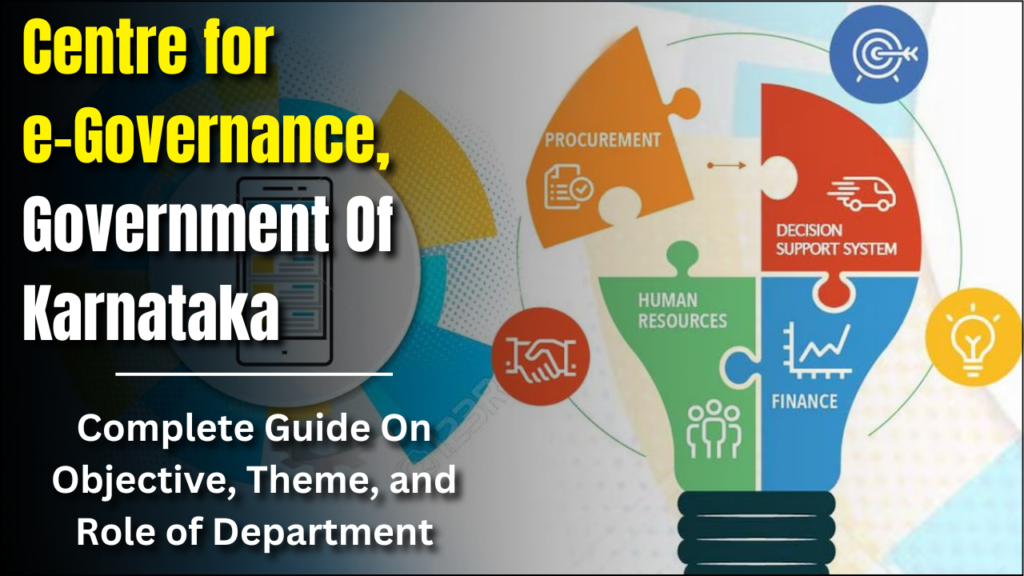
The govt of Karnataka is the first organization that is working on the model of excellence in Information & Communication Technology (ICT) governance and the govt is actively leading e-governance initiatives across the country. The e-Governance division was established in 2003. It operates under the Dept of Personnel and Administrative Reforms (DPAR). This dept focuses on accelerating IT-enabled processes to enhance transparency, improve administrative efficiency, and provide better electronic service delivery to citizens.
The role of the Department of eGovernance includes
- Establishing a policy framework to define the vision and guidelines for e-Governance projects.
- Developing an administrative framework for approving e-governance initiatives across all departments.
- Building and maintaining core e-infrastructure to support departments in planning and executing e-governance initiatives.
- Formulating and promoting common standards for designing e-Governance projects.
Centre for e-Governance
CeG, in collaboration with the Dept of e-Governance, has expanded into various innovative projects to ensure that every citizen can access the benefits and schemes introduced by the State Government. Additionally, CeG has played a key role in helping the State Government establish two advanced data centers, the Karnataka State Wide Area Network (KSWAN) powered by MPLS technology, and core applications such as e-Procurement and HRMS.
Projects Managed By Centre for e-Governance
Core Infrastructure Projects
The State Data Centre (SDC), Karnataka State Wide Area Network (KSWAN), Secretariat Local Area Network (SecLAN), Mobile One, Mailing Service, and other initiatives serve as foundational pillars enabling the operation and execution of all e-Governance projects across the State.
Core Enterprise Applications
Key enterprise applications, including the Human Resource Management System (HRMS), e-Procurement, and Sachivalayavahini, function across multiple departments, users, and citizens. Additionally, Aadhaar or UID facilitates the enrolment of Karnataka’s residents.
Capacity Building
Capacity Building focuses on developing specific skills and expertise among government personnel to effectively implement and manage e-governance projects. It also supports government departments in planning and executing e-governance initiatives.
Objective
- Enable the swift and efficient application of Information Technology to benefit the general public.
- Design, implement, and oversee e-governance initiatives to support the State Government’s objective of delivering IT and IT-enabled services to citizens.
- Offer technical assistance to Government Departments and entities for their IT projects.
- Develop and manage centralized, web-based data storage systems.
- Deliver citizen-focused services, including access to information, services, and goods.
- Collaborate with Government Departments and entities while executing key projects that serve multiple departments.
Vision
To improve and promote the use of information technology in government operations, ensuring accessible information for all citizens, delivering services efficiently and seamlessly, and facilitating the identification of services online.
Mission
Enable people in both rural and urban areas by enhancing service delivery through online accessibility, public engagement, and seamless transactions, fostering economic growth and driving visible transformation.
Key themes of government’s future e-Governance direction
Empowering Citizens
Citizens should have easy access to information about government processes and responsibilities, fostering greater government accountability.
Enhanced Service Delivery
Government services should be easily accessible to citizens, offering flexibility in the choice of channels while maintaining consistent quality and security.
Promoting Economic Development
Efforts should focus on improving citizens’ overall standard of living and positioning the state as a preferred destination for individuals and businesses.
Web Presence
Government departments should establish websites to provide the public with basic information.
Interactive Platforms
Departments should expand their websites to enable online access to essential information, form downloads, and communication with agencies via email, reducing the need for physical office visits.
Transactional Services
Self-service applications should be added to government websites, allowing users to complete transactions online. These services should be available 24/7, regardless of location, and integrate seamlessly across various agencies to improve service delivery.
Transformative Solutions
Government service delivery and operations should evolve to integrate information, services, and processes across traditional boundaries, redefining how services are provided and managed.
e-Governance Growth Phases
The e-Governance strategy focuses on service-specific rather than department-specific initiatives. Services are implemented progressively, with a phased approach ensuring tangible benefits for citizens and the government. Implementation priorities are determined based on feasibility, complexity, and benefits to stakeholders. Services are rolled out in three waves:
Wave 1: Raise Visibility
This phase focuses on quickly enhancing the Government of Karnataka’s reputation as an e-governance leader by establishing a professional and effective web presence.
Wave 2: Build Critical Transactional Services
This phase introduces transactional capabilities to critical services, enabling citizens to interact with government departments. Services implemented in Wave 1 may be upgraded during this phase as part of the e-Governance transformation.
Wave 3: Sustain Value
In this phase, the government adds more transactional services to enhance and sustain the value provided to citizens, ensuring long-term success and satisfaction.